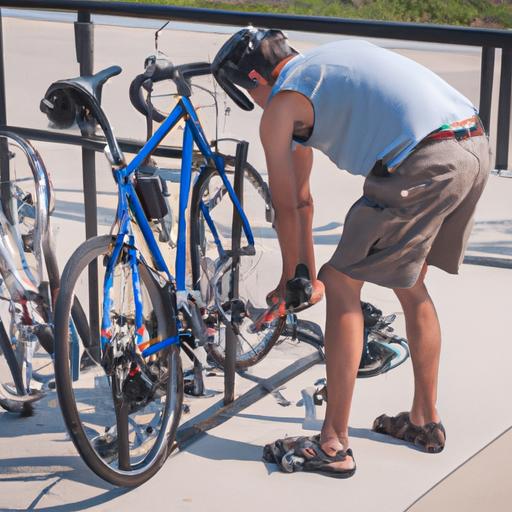Bike Rack Reviews: Finding the Perfect Rack for Your Cycling Adventures
Looking for the best bike rack to transport your bike to different locations? Check out our bike rack reviews and find the perfect one for you!
As a passionate cyclist, you understand the significance of having the right equipment for your rides. One essential piece of equipment that enhances convenience and safety is a bike rack. With the market flooded with numerous options, selecting the ideal bike rack might seem overwhelming. But worry not! In this article, we will delve into bike rack reviews and help you discover the perfect one for your specific needs.
Exploring the Different Types of Bike Racks
When it comes to bike racks, there are several types available. Each type has its advantages and disadvantages, so it’s important to consider your needs.
Hitch-Mounted Bike Racks
Hitch-mounted bike racks, which attach to the hitch receiver on the back of your vehicle, are a popular choice among cyclists. They come in two types: platform and hanging. Platform hitch-mounted bike racks hold the bike by the wheels, providing a stable platform for transportation. On the other hand, hanging hitch-mounted bike racks hold the bike by the frame and are more affordable. However, they can potentially damage the bike’s frame and are not as stable as platform racks.
Pros
- Easy installation and use
- Ability to hold multiple bikes
- Provides easy access to the trunk of your vehicle
Cons
- Can be heavy and difficult to store
- May obstruct the license plate and taillights on your vehicle
- Requires a hitch receiver

Roof-Mounted Bike Racks
Roof-mounted bike racks are designed to attach to the roof of your vehicle and hold the bike in an upright position. They are an excellent choice for vehicles with a low roofline and can accommodate various bike sizes and styles.
Pros
- Can hold multiple bikes
- Does not obstruct the trunk or rearview mirror
- Provides easy access to the bike
Cons
- Requires lifting the bike onto the roof
- May increase wind resistance and decrease fuel efficiency
- Incorrect installation can damage the bike
Trunk-Mounted Bike Racks
Trunk-mounted bike racks attach to the trunk of your vehicle and use straps to hold the bike in place. They are a popular choice due to their affordability and convenience.
Pros
- Affordable and easy to use
- Can hold multiple bikes
- Does not require a hitch receiver
Cons
- Can potentially damage the vehicle’s paint and body
- May obstruct the trunk and rearview mirror
- Not as secure as other types of bike racks
Spare Tire-Mounted Bike Racks
Spare tire-mounted bike racks are specifically designed to attach to the spare tire on the back of your vehicle. They are an excellent choice for SUVs and Jeeps. These racks are easy to install and use, and some can accommodate one or two bikes.
Pros
- Easy to install and use
- Does not require a hitch receiver
- Can hold multiple bikes
Cons
- Can obstruct the license plate and taillights on your vehicle
- Can be heavy and difficult to store
- Limited to vehicles with a spare tire on the back
Choosing the right bike rack depends on your needs and the type of vehicle you own. Consider the pros and cons of each type before making your decision.
Top Bike Racks on the Market
If you’re in search of a bike rack, you’ll find plenty of options available. To help you narrow down your choices, we have compiled a list of the top bike racks currently on the market. Let’s dive into each one:
Thule T2 Pro XT 2 Bike Rack
The Thule T2 Pro XT 2 Bike Rack is a hitch-mounted rack capable of holding up to two bikes. It features an easy-to-use hitch switch lever, adjustable bike mounts to prevent interference, and integrated cable locks for added security.
Pros
- Easy installation and use
- No contact with the bike frame, reducing the risk of damage
- Durable and sturdy
Cons
- Comparatively expensive
- Some bike frames may require an adapter
Yakima HighRoad Bike Rack
The Yakima HighRoad Bike Rack is a roof-mounted rack suitable for one bike. It boasts a torque knob for frame pressure adjustment, a sleek design to reduce wind noise, and a tool-free installation process.
Pros
- Easy to load and unload
- No contact with the bike frame, reducing the risk of damage
- Fits a wide variety of bike frames
Cons
- Limited to accommodating one bike
- May require an additional roof rack system
Saris Bones 2-Bike Trunk Rack
Designed as a trunk-mounted rack, the Saris Bones 2-Bike Trunk Rack can hold up to two bikes. It offers adjustable arms and legs to fit various vehicles, rubberized hooks to protect your vehicle’s paint, and a lightweight design for effortless storage.
Pros
- Affordable compared to other bike racks on the market
- Easy installation and use
- Fits a wide variety of vehicles
Cons
- May require additional straps for enhanced attachment security
- Limited to accommodating two bikes
When it comes to choosing a bike rack, it’s crucial to consider your specific needs and preferences. If multiple bike storage and security are your priorities, the Thule T2 Pro XT 2 Bike Rack might be the best option. Alternatively, if you already have a roof rack system and prefer a sleek, user-friendly design, the Yakima HighRoad Bike Rack could be the ideal choice. Lastly, the Saris Bones 2-Bike Trunk Rack is a budget-friendly option that can accommodate up to two bikes.
Considerations When Choosing a Bike Rack
Selecting the right bike rack involves considering various factors to ensure a perfect match for your needs. Here are some important things to ponder before making a purchase:
Compatibility with Different Types of Vehicles
Before purchasing a bike rack, it’s crucial to ensure compatibility with your vehicle. Different racks are specifically designed to fit certain types of vehicles, such as sedans, SUVs, trucks, or hatchbacks. While some racks are universal, it’s always essential to double-check compatibility before making your final decision.
Capacity and Weight Limitations
The capacity and weight limitations of a bike rack are vital considerations. Different racks have varying weight limits, so it’s essential to choose one that can handle the weight of your bike. If you plan on transporting multiple bikes, ensure the rack can accommodate your needs.
Also, keep in mind the weight of the rack itself. Heavier racks can affect your vehicle’s gas mileage and handling, particularly during frequent use. Opt for a lightweight and easy-to-handle rack when considering long-term usage.
By carefully considering compatibility with different vehicle types, capacity, and weight limitations, you can ensure that you choose the perfect bike rack for your cycling adventures. Keep these factors in mind as you review various options to make the best decision for your needs.
Tips for Installing and Using Bike Racks
Using a bike rack safely is crucial for your bike’s wellbeing and the safety of other drivers. Here are some tips to help you install and use your bike rack effectively:
Step-by-Step Guide for Installing a Bike Rack
Installing a bike rack may seem daunting, especially if you’re new to it. However, with the right instructions, it can be a simple process. Follow these steps to install your bike rack:
- Determine the type of bike rack you have and the type of vehicle you’re installing it on.
- Thoroughly read the instructions that came with your bike rack before starting the installation process.
- Clean the attachment area to ensure a secure connection.
- Follow the manufacturer’s recommendations and attach the bike rack to your vehicle.
- Ensure the bike rack is secure and stable before placing your bike on it.
Tips for Using a Bike Rack Safely
Ensuring the safety of your bike during transportation is vital. Here are some tips to keep in mind when using a bike rack:
- Before each use, check the bike rack and its connection points to ensure they are secure.
- Use straps or locks to secure your bike to the rack, preventing movement during transportation.
- Be mindful of the weight limit specified for your rack and avoid exceeding it.
- Avoid overloading the rack with too many bikes, as this can cause instability during transportation.
- Exercise caution when driving with a bike rack attached to your vehicle. Remember that the added weight can affect your car’s handling, especially when braking or turning.
Maintenance and Care Instructions for Bike Racks
Maintaining your bike rack is essential to ensure its longevity, safety, and functionality. Consider these tips when it comes to maintenance and care:
- Regularly clean the bike rack to remove dirt and debris that can cause damage or corrosion.
- Inspect the rack for any signs of wear or damage and promptly repair or replace any compromised parts.
- Lubricate the moving parts of the rack to ensure smooth operation.
- Store the rack in a dry place when not in use to prevent corrosion.
- Adhere to the manufacturer’s instructions for maintenance and care, as they may have specific recommendations for your bike rack model.
Conclusion
In conclusion, finding the perfect bike rack is crucial for any cyclist. Although the market offers an array of options, taking into account your vehicle type, the number of bikes you need to transport, and your budget can help narrow down your choices.
In this article, we explored the different types of bike racks, reviewed some of the top options available, provided tips for choosing and using bike racks, and summarized our findings. We hope this article has helped you in your quest to find the best bike rack for your needs.
Remember, a bike rack is an investment in your cycling adventures, so choose wisely. For additional guidance, we recommend visiting your local bike shop to consult with experts and inspect the available options in person.
At Facts of Bike, our mission is to provide cyclists with the information they need to make informed decisions about their gear. We hope this article has been valuable and informative for you. Happy cycling, and don’t forget to pack your bike rack for your next adventure!







